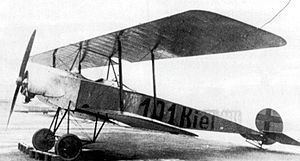Wingspan 9.94 m Manufacturer Fokker | Length 7.49 m | |
 | ||
The Fokker M.7 was a German observation aircraft of World War I, used by the armed forces of both Germany and Austro-Hungary.
Contents
Design and development
Twenty aircraft, powered by 60 kW (80 hp) Oberursel U.0 rotary engines, were built, some of which were used by Kaiserliche Marine (Imperial German Navy) shore stations. It was a single-bay sesquiplane (biplane) of conventional configuration, with slightly staggered wings using wing warping for roll control, tandem open cockpits and Fokker's distinctive comma-shaped rudder.
The W.3 / W.4 was a floatplane version of the M.7.
Operational history
The aircraft was operated by the Austro-Hungarian forces under the designation Type B.I, following the German Empire's lettered prefixes from the Idflieg aircraft designation system.
Variants
Operators
Specifications (M.7)
Data from Data from Das Virtuelle Luftfahrtmuseum
General characteristics
Performance
